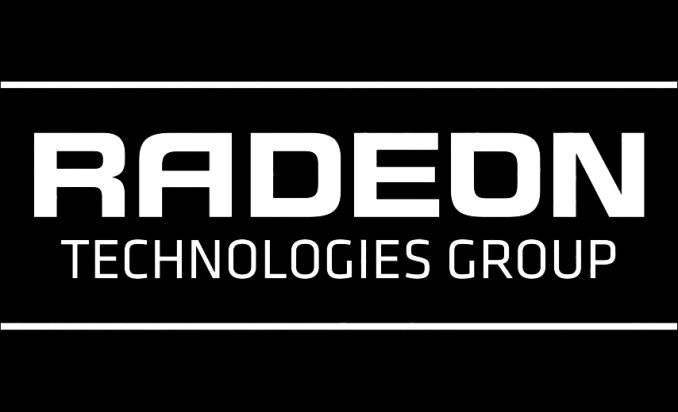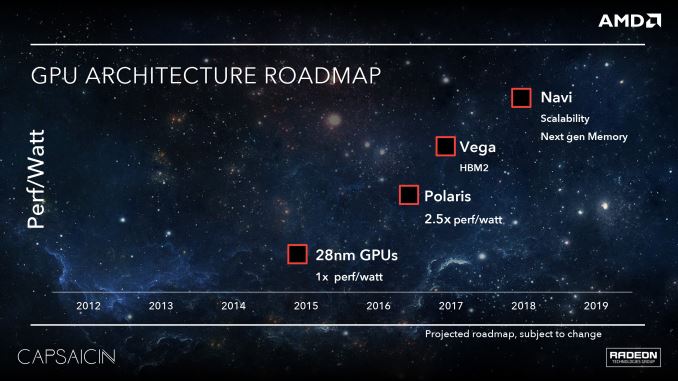AMD Unveils GPU Architecture Roadmap: After Polaris Comes Vega
by Ryan Smith on March 15, 2016 3:30 AM EST
Although AMD’s GDC 2016 “Capsaicin” event was primarily focused on game development – it is the Game Developers Conference, after all – AMD did spend a brief moment discussing their future GPU plans. For the first time in many years, AMD has published a GPU architecture roadmap.
Plotting perf/watt against the years, AMD’s roadmap unveils two new architectures: Vega, and Navi. Essentially everything there is to know about these architectures is in this slide – AMD is being tight-lipped regarding further details – but this map gives us some tantalizing new information to work with.
Vega is currently scheduled to come relatively quickly after Polaris. Depending on how literal you interpret this chart, the far left edge of the Vega box does fall into 2016, though obviously AMD intends to leave themselves some wiggle room here and not tie themselves down to specific dates. The fact that Vega comes this soon after Polaris is interesting; it seems hard to believe that it’s a direct successor to Polaris – I can’t see AMD replacing Polaris parts in less than a year – so this points to Vega being more of a cousin, and is where AMD’s naming system isn’t especially helpful in deciphering anything further.
With Polaris confirmed to use GDDR5, Vega is notable for being the first AMD architecture to use HBM2, and the first parts in general to use HBM tech since Fiji. I’m presuming these are higher-end GPUs to complement the Polaris GPUs (the smaller of which we know to be a low-power laptop design), which is where HBM would be more cost-effective, at least at current prices.
Meanwhile AMD has also confirmed the number of GPUs in the Vega stack and their names. We’ll be seeing a Vega 10 and a Vega 11. This follows Polaris GPU naming – which has finally been confirmed – with Polaris 10 and Polaris 11. I have also been told that Polaris 11 is the smaller of the Polaris GPUs, so at this point it’s reasonable to assume the same for Vega.
Finally, farther out towards 2018 is an architecture AMD is calling Navi. This one I suspect will attract the most attention (even if it’s the farthest out) due to the ambiguity of its features: “scalability” and “next gen memory”. Similar to how it’s hard to see Vega directly replacing Polaris, it’s hard to see Navi directly replacing Vega after only a year. This leaves Navi rife for speculation; I could very well see it being a Polaris replacement since we’ll be nearly 2 years past Polaris, or perhaps something to do with AMD’s APU plans. Either way I don’t expect that this will be the last time AMD teases it before finally launching it.

















54 Comments
View All Comments
plopke - Tuesday, March 15, 2016 - link
Wait so no HBM2 , no GDDR5X but just plain GDDR5 , well that is a suprize.Since it is a perf/watt slide that gain for vega is then mainly the memory?
Personally i was kinda hoping to see cards with 8gb(>=6GB) becoming standard in 2016. So wondering :
-they trying to get it out really early to the market ?
-something went wrong?
-Hope for AMD that NVIDIA doesn't suprize them and getting HBM2/GDDR5X out on their sub 20nm.
Eschaton - Tuesday, March 15, 2016 - link
My guess would be that the market shifted under their feet and they're trying to respond. When work on HBM began, VR wasn't a thing yet. With the advent of VR and a general gaming focus on improving textures and supersampling, the 4gb limit that HBM offered suddenly seemed restrictive. From there, AMD also decided it didn't want to invest in competing technologies, so it stepped back to good old reliable DDR5 to bring cards with lots of vRAM to the market.I'd still be really surprised if Polaris didn't feature ANY SKUs with HBM; HBM is great for situations where you are space or bandwidth constricted.
I too hope this doesn't mean Nvidia gets the drop on them with HBM2; AMD really can't afford to lose that way to Nvidia right now.
Qwertilot - Tuesday, March 15, 2016 - link
No need to overcomplicate things :)These are going to be quite high volume cards, and at least eventually moderately priced as well. HBM doesn't suit that much. They might throw it in for a top end card or something, but you can imagine not.
Very likely that NV will get HMB2 out first from this roadmap - they need that for the big pascal based Tesla's and they've got contracts for those shipping relatively soon. How soon that becomes relevant for the consumer market maybe another matter!
prtskg - Wednesday, March 16, 2016 - link
Since both Samsung and Hynix show q3 for volume production of HBM2, I don't think any 'reasonably priced' gpu will feature it till q4.extide - Tuesday, March 15, 2016 - link
Where are you hearing no GDDR5X? I bet we will see GDDR5X on Polaris 10, at least!samlebon2306 - Tuesday, March 15, 2016 - link
"Where are you hearing no GDDR5X?"Because GDDR5X will get produced in mass only this summer, so AMD has no control here.
edzieba - Tuesday, March 15, 2016 - link
"I have also been told that Polaris 11 is the smaller of the Polaris GPUs, so at this point it’s reasonable to assume the same for Vega."That's interesting. Over at Techreport (http://techreport.com/blog/29851/radeon-pro-duo-sp...
"Polaris 10 is AMD's "console-class" graphics card for thin-and-light notebooks. The company expects that graphics chips and cards using Polaris 10 silicon will be able to deliver as much as two times the performance per watt of Nvidia's GeForce GTX 950. The company says that it demonstrated Polaris 11 in December of last year. If that's the case, a Polaris 11 chip running Star Wars Battlefront at 1080p and 60 FPS drew about 90W at the wall."
If Polaris 11 is the smaller GPU, then the 'console class' Polaris 10 would end up with a TDP higher than 90W, which doesn't make sense for notebooks.
narlzac85 - Tuesday, March 15, 2016 - link
Could Navi possibly be a new multi-GPU design of Vega with >1 GPU sharing the HBM interposer and memory (shared memory design)?'scalability' and 'next-gen memory'...seems to fit.
MrSpadge - Tuesday, March 15, 2016 - link
That would make a lot of sense. Smaller dies (better yield) with very fast interconnects through an interposer could logically work in the same way as a monolithic big GPU. With exploding mask costs at smaller nodes reducing the number of different dies would bring major cost benefits.name99 - Wednesday, March 16, 2016 - link
Insofar as there is "new design" coming, maybe it is targeted at AI?IF AI is going to be the breakout market over the next ten years, it would make sense to tweak to GPU to better accommodate whatever AI wants.
Or to put it differently, if AMD thinks they can survive purely on doing VR well, and leaving nV to pick up the AI market (with all those data warehouses), they're, IMHO, making a nasty mistake.